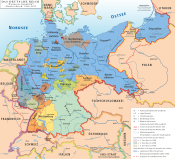Free State of Oldenburg
| Free State of Oldenburg Freistaat Oldenburg | |||||||||||||
|---|---|---|---|---|---|---|---|---|---|---|---|---|---|
| State of Germany | |||||||||||||
| 1918–1946 | |||||||||||||
 Location of Oldenburg within Germany | |||||||||||||
| Capital | Oldenburg | ||||||||||||
| Area | |||||||||||||
• 1925 | 6,427 km2 (2,481 sq mi) | ||||||||||||
| Population | |||||||||||||
• 1925 | 545,172 | ||||||||||||
| • Type | Republic | ||||||||||||
| History | |||||||||||||
• Established | 1918 | ||||||||||||
• Disestablished | 1946 | ||||||||||||
| |||||||||||||
The Free State of Oldenburg (German: Freistaat Oldenburg) was a state of the Weimar Republic. It was established in 1918 following the abdication of the Grand Duke Frederick Augustus II following the German Revolution.
In 1937, it lost the exclave districts of Eutin near the Baltic coast and Birkenfeld in southwestern Germany to Prussia and gained the City of Wilhelmshaven; however, this was a formality, as the Hitler regime had de facto abolished the federal states in 1934.
By the beginning of World War II in 1939, as a result of these territorial changes, Oldenburg had an area of 5,375 km2 (2,075 sq mi) and 580,000 inhabitants.
After World War II, Oldenburg was merged into the newly founded state of Lower Saxony as the administrative region (Verwaltungsbezirk) of Oldenburg, both of which became a part of Federal Republic of Germany in 1949. The two enclaves became part of the States of Schleswig-Holstein and Rheinland-Pfalz respectively.
See also



